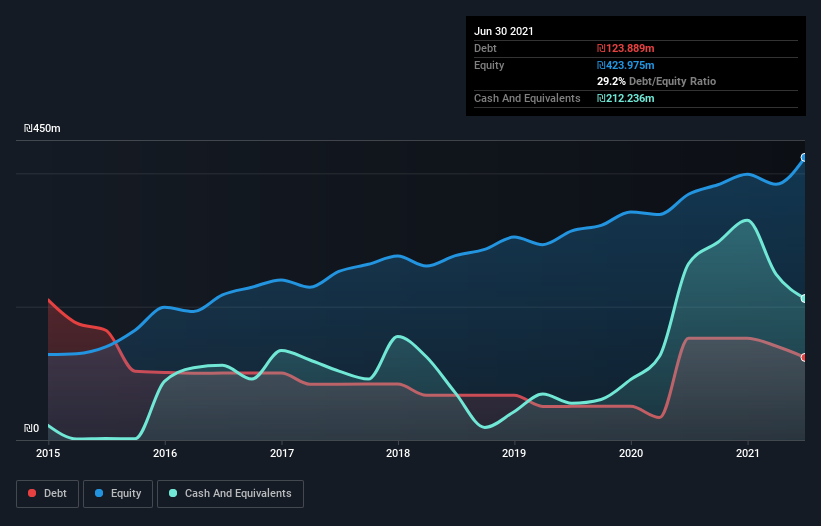Warren Buffett famously said, 'Volatility is far from synonymous with risk.' When we think about how risky a company is, we always like to look at its use of debt, since debt overload can lead to ruin. We note that Tadiran Group Ltd (TLV:TDRN) does have debt on its balance sheet. But the more important question is: how much risk is that debt creating?
When Is Debt Dangerous?
Debt assists a business until the business has trouble paying it off, either with new capital or with free cash flow. If things get really bad, the lenders can take control of the business. However, a more common (but still painful) scenario is that it has to raise new equity capital at a low price, thus permanently diluting shareholders. Of course, debt can be an important tool in businesses, particularly capital heavy businesses. The first thing to do when considering how much debt a business uses is to look at its cash and debt together.
See our latest analysis for Tadiran Group
What Is Tadiran Group's Net Debt?
The image below, which you can click on for greater detail, shows that Tadiran Group had debt of ₪123.9m at the end of June 2021, a reduction from ₪152.6m over a year. But on the other hand it also has ₪212.2m in cash, leading to a ₪88.3m net cash position.

A Look At Tadiran Group's Liabilities
We can see from the most recent balance sheet that Tadiran Group had liabilities of ₪425.9m falling due within a year, and liabilities of ₪139.8m due beyond that. Offsetting these obligations, it had cash of ₪212.2m as well as receivables valued at ₪316.7m due within 12 months. So it has liabilities totalling ₪36.9m more than its cash and near-term receivables, combined.
This state of affairs indicates that Tadiran Group's balance sheet looks quite solid, as its total liabilities are just about equal to its liquid assets. So it's very unlikely that the ₪3.57b company is short on cash, but still worth keeping an eye on the balance sheet. Despite its noteworthy liabilities, Tadiran Group boasts net cash, so it's fair to say it does not have a heavy debt load!
On top of that, Tadiran Group grew its EBIT by 56% over the last twelve months, and that growth will make it easier to handle its debt. There's no doubt that we learn most about debt from the balance sheet. But you can't view debt in total isolation; since Tadiran Group will need earnings to service that debt. So if you're keen to discover more about its earnings, it might be worth checking out this graph of its long term earnings trend.
Finally, a business needs free cash flow to pay off debt; accounting profits just don't cut it. Tadiran Group may have net cash on the balance sheet, but it is still interesting to look at how well the business converts its earnings before interest and tax (EBIT) to free cash flow, because that will influence both its need for, and its capacity to manage debt. During the last three years, Tadiran Group produced sturdy free cash flow equating to 77% of its EBIT, about what we'd expect. This cold hard cash means it can reduce its debt when it wants to.
Summing up
We could understand if investors are concerned about Tadiran Group's liabilities, but we can be reassured by the fact it has has net cash of ₪88.3m. And it impressed us with its EBIT growth of 56% over the last year. So is Tadiran Group's debt a risk? It doesn't seem so to us. When analysing debt levels, the balance sheet is the obvious place to start. However, not all investment risk resides within the balance sheet - far from it. For instance, we've identified 1 warning sign for Tadiran Group that you should be aware of.
At the end of the day, it's often better to focus on companies that are free from net debt. You can access our special list of such companies (all with a track record of profit growth). It's free.
Valuation is complex, but we're here to simplify it.
Discover if Tadiran Group might be undervalued or overvalued with our detailed analysis, featuring fair value estimates, potential risks, dividends, insider trades, and its financial condition.
Access Free AnalysisThis article by Simply Wall St is general in nature. We provide commentary based on historical data and analyst forecasts only using an unbiased methodology and our articles are not intended to be financial advice. It does not constitute a recommendation to buy or sell any stock, and does not take account of your objectives, or your financial situation. We aim to bring you long-term focused analysis driven by fundamental data. Note that our analysis may not factor in the latest price-sensitive company announcements or qualitative material. Simply Wall St has no position in any stocks mentioned.
Have feedback on this article? Concerned about the content? Get in touch with us directly. Alternatively, email editorial-team (at) simplywallst.com.
About TASE:TDRN
Tadiran Group
Engages in the development, manufacturing, marketing, import, distribution, and sale of air conditioners and air treatment systems Israel, Europe, and internationally.
Adequate balance sheet and fair value.
Market Insights
Community Narratives




